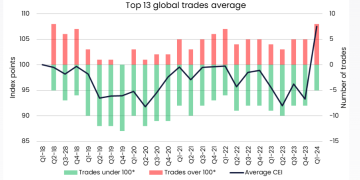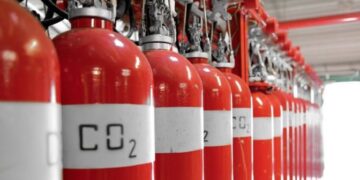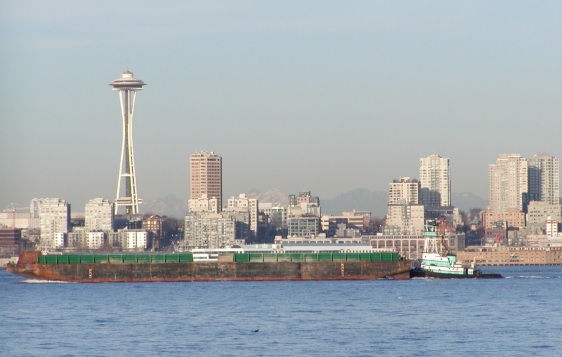Ports are the main gateway for global trade and are critical to the U.S. economy. Thousands of diesel-powered vessels, trucks, cranes, and other equipment help transport goods to market. But as they do, they also emit greenhouse gases, smog- and soot-causing nitrogen oxides (NOx), particulate matter, and other harmful pollutants. These emissions contribute to climate change and can cause asthma attacks, emergency room visits, heart attacks, and premature death. People living near ports bear the brunt of this pollution, and they often live in minority or low income communities.
In 2014, I was privileged to stand beside Bob Perciasepe, then Deputy Administrator of EPA and other key port stakeholders to launch our Ports Initiative, which aims to reduce air pollution and greenhouse gases from ports to improve the quality of life for all Americans working in and living near them.
Yesterday, in support of the Ports Initiative, we released a report titled the National Port Strategy Assessment: Reducing Air Pollution and Greenhouse Gases at U.S. Ports. This report assessed a wide variety of strategies and technologies available to ports and port operators to reduce emissions. The assessment shows that there are many effective, proven opportunities available right now to reduce harmful pollution at ports. This is great news for the roughly 39 million Americans who live and breathe near these centers of commerce. Port stakeholders including state and local governments, ports and port operators, tribes, and neighboring communities can use this information to help inform priorities and decisions about investments being planned now for their port area.
This information comes at a critical time. With the Panama Canal expansion, U.S. seaports, private-sector partners, and the federal government are primed to spend billions of dollars on port freight and passenger infrastructure over the next five years. Decisions about port investments will have a lasting impact on the health of our citizens and our planet. It is more important than ever to make sure that port planning includes projects to reduce emissions and protect the environment.
Every type and size of port, whether they are seaports or Great Lakes and river ports, can use the information in the assessment to better understand how to reduce emissions now and into the future. The assessment found that replacing and repowering older, dirtier vehicles and engines with ones that meet our cleaner diesel standards achieves large emission reductions in NOx, particulate matter, and other pollutants that affect air quality. For example, replacing older drayage trucks could reduce NOx emissions by almost half, and particulate matter emissions by up to 62 percent in 2020 as compared to continuing with no changes. With regard to greenhouse gases, the report highlights that electrification of port vehicles and equipment can effectively reduce the magnitude of greenhouse gas emissions growth below what would happen in the absence of this replacement.
Certainly, there are things that are already having a positive impact on pollution from ports. For one, our emissions standards for new trucks, locomotives, cargo handling equipment, and ships are reducing diesel emissions from the vehicles and engines that are so critical to many port operations. In addition, our Diesel Emissions Reduction Act grant programhas accelerated turnover of older diesel equipment at ports and goods movement hubs resulting in additional reductions. And finally, some port areas are taking proactive steps to reduce emissions.
Despite these gains, more work is needed to fully address the ongoing public health and climate impacts of the projected growth at U.S. ports. I look forward to continuing our efforts to provide data and information to inform decisions that effectively reduce pollution and result in more sustainable ports for the 21st century. This report is another important step in that direction.
[divider]
U.S. EPA has issued report to examine current and future emissions from a variety of diesel sources operating in port areas, and to explore the potential of a range of available strategies to reduce emissions from port-related trucks, locomotives, cargo handling equipment, harbor craft, and ocean-going vessels. Learn more by clicking here.
The views presented hereabove are only those of the author and not necessarily those of GREEN4SEA and are for information sharing and discussion purposes only.
[divider]
About Chris Grundler

Christopher Grundler is the Director of the Office of Transportation and Air Quality (OTAQ) for the U.S. Environmental Protection Agency (EPA). Prior to being appointed Director, he served as the Deputy Office Director and Chief Executive of the National Vehicle and Fuel Emissions Laboratory located in Ann Arbor, Michigan. He and a staff of nearly 400 employees strive to protect public health and the environment by reducing air pollution from transportation vehicles, engines, and the fuels used to operate them.
Grundler and his team establish and implement national emissions standards for transportation fuels and vehicles, as well as a variety of off road equipment. These mobile sources include cars and light trucks, heavy trucks and buses, nonroad engines, marine vessels, and airplanes. OTAQ is also responsible for implementing important aspects of the Energy Independence and Security Act, including establishing national renewable fuel standards. OTAQ is continuously evaluating a wide variety of advanced technology strategies which have the potential to reduce harmful emissions and fuel consumption.
Since joining EPA in 1980, Mr. Grundler has held a number of senior leadership positions within the Agency including Director of the Office of Federal Facilities Enforcement and Director of the Great Lakes National Program Office. Mr. Grundler has also served at the U.S. Department of Energy, where he helped create the Department’s first environmental audit program. Mr. Grundler has been awarded the Gold Medal for Exceptional Service, EPA’s highest honor. In 2008 he received the Presidential Award for Meritorious Senior Executives.
Mr. Grundler was part of the team that developed the nation’s first greenhouse gas emission standards for both light- and heavy-duty vehicles. Prior to that, he helped bring a slate of clean diesel standards for cars, trucks, and construction equipment. In addition, he administered a five year modernization program for EPA’s National Vehicle and Fuel Emissions Laboratory, the nation’s premier facility for testing and evaluating clean automotive technology.
Mr. Grundler holds a Bachelor of Science degree in Civil and Environmental Engineering from the University of Michigan for which he is an avid sports enthusiast. He was raised in Michigan and divides his time between Washington, D.C. and Ann Arbor, Michigan.





























































